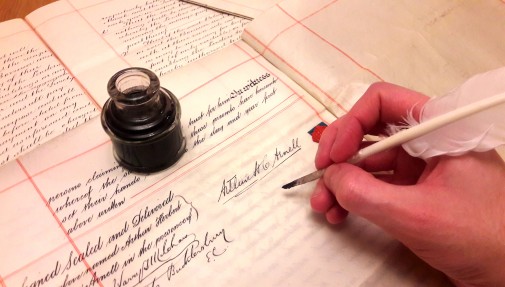Sheepskin was the anti-fraud device of choice for lawyers for hundreds of years, study shows
Posted on 24 March 2021
 The study suggests the structure of sheepskin made attempts to remove or modify text obvious.
The study suggests the structure of sheepskin made attempts to remove or modify text obvious.
Researchers - including academics from the University of York - have discovered they almost always used sheepskin, rather than goatskin or calfskin vellum, when writing their legal documents during the 13th to 20th Century.
The study suggests this may have been because the structure of sheepskin made attempts to remove or modify text obvious.
Researchers used an analytical technique pioneered at the University of York which uses proteins, such as collagen, preserved in archaeological and historic artefacts to identify the species from which they derive. Typically, this technique called Zooarchaeology by Mass Spectrometry (ZooMS) is applied to bone fragments, but in this case was applied to historic parchment.
Exploited
Co-author Professor Jonathan Finch from the Department of Archaeology said: “What our research reveals is that there was a sophisticated understanding of the properties of different products and that these could be exploited. In the case of sheepskin parchment, its properties were used to prevent fraud by the surreptitious alteration of important legal documents.
"The structure of the skin clearly showed up any attempt to erase or alter the original text. The success of this study opens up new potential in the study of animal products over the historical period."
Sheep deposit fat in-between the various layers of their skin. During parchment manufacture, the skin is submerged in lime, which draws out the fat leaving voids between the layers. Attempts to scrape off the ink would result in these layers detaching - known as delamination - leaving a visible blemish highlighting any attempts to change any details.
Sheepskin has a very high fat content, accounting for as much as 30 to 50 per cent, compared to three to 10 per cent in goatskin and just two to three per cent in cattle. Consequently, scraping or erasing is far more likely to detach these layers in sheepskin than those of other animal skins.
Security
The continuing use of sheepskin over goat or calfskin in later centuries was likely influenced by their greater availability and lower cost.
Dr Sean Doherty, an archaeologist from the University of Exeter who led the study, said: “Lawyers were very concerned with authenticity and security, as we see through the use of skins. But it now appears as though this concern extended to the choice of animal skin they used too.”
Because they are so durable, millions of old legal documents survive in British archives and private collections, but they are often neglected because of their supposed lack of historic value. Many were discarded, burnt, or even repurposed into lamp shades during the 20th century after the Land Registry Act of 1925 meant they didn’t need to be kept by owners or lawyers.
Until now so little was known about these documents, many were incorrectly catalogued as calfskin vellum, when they were actually made of sheepskin parchment.
Skin
Dr Doherty added: “Modern research techniques mean we can now not only read the text, but the biological and chemical information recorded in the skin. As physical objects they are an extraordinarily molecular archive through which centuries of craft, trade and animal husbandry can be explored.”
Surviving texts note the use of sheepskin as an anti-fraud device. The 12th century text Dialogus de Scaccario - written by Richard FitzNeal, Lord Treasurer during the reigns of Henry II and Richard I - instructs the use of sheepskin for royal accounts as “they do not easily yield to erasure without the blemish being apparent”.
In the 17th century when paper was common, Chief Justice Sir Edward Coke wrote of the necessity that legal documents were written on parchment “for the writing upon these is least liable to alterations or corruption.”
Explore more news

Climate change set to take over as key driver of biodiversity loss by 2050, experts warn
Thursday 25 April 2024

Conservation actions are effective at halting and reversing biodiversity loss, study reveals
Thursday 25 April 2024

More than a quarter of people with Covid infection develop Long Covid, new research reveals
Thursday 25 April 2024
.jpg)
University of York awarded £1.1 million to lead the first stage of UK’s first comprehensive study on devolution and social security
Thursday 25 April 2024

More hybrid and nature-based solutions are urgently need to protect coastal communities from climate change
Wednesday 24 April 2024
Media enquiries
About this research
The paper, “Scratching the Surface: the use of sheepskin parchment to deter textual erasure in early modern legal deeds” is published in the journal, Heritage Science.
Explore more of our research.
